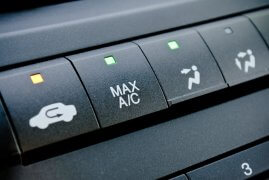Fluid Leaks on Your Driveway and How to Recognize the Source

Unless you happen to be an auto mechanic or married to one, figuring out the source of a fluid leak can be like solving a riddle. Those pesky drips on your driveway come from some place – but, where? They could be coming from the engine or the transmission or maybe from any number of other places.
Of course, anything dripping from your vehicle should be taken seriously as it could indicate a dangerous issue that requires your immediate attention. You don’t want to get stranded because you neglected a simple drip on your driveway one morning that turns into expensive repairs or an accident that affects your auto insurance rates.
By knowing what to look for, you can keep your vehicle running safely on the road and possibly save yourself a ton of cash.
First, you have to be aware that there are six fluids you may need to address either right away or at the earliest convenience. Below are those six:
Water
Of all the potential fluid leaks, water should be the least concerning. The reason for this is your air conditioner, through its normal operation, will drain the moisture it removes from the air inside your passenger compartment. Typically, a puddle forms on the ground near where the passenger rests his feet. So, if you see water after running your a/c, it shouldn’t be anything to worry about.

Motor Oil
Motor oil will come from your engine and an occasional little drop is no reason to panic. While the color may vary, depending on how you maintain your vehicle, it will range from a light amber color to a dark brown. It may not be immediately obvious from what part of the engine the drips are coming from, but an engine oil leak can be the beginning of a bigger problem and should be checked out by a mechanic. In the meantime, pull out the dipstick for a quick visual inspection and maintain the oil level.

Transmission fluid
If you have an automatic transmission and you spot red or pink fluid under your car, it’s often the first sign it will start slipping and eventually not move should you wait to have the leak repaired. As with engine oil, pull the transmission dipstick and check your fluid level. The more fluid on your driveway – the more serious the problem. Therefore, consult a mechanic as soon as possible to avoid further damage.
Standard (“manual”) four, five, and six-speed transmissions use gear oil, which is heavier and stronger-smelling than engine oil. In most cases, checking the level on a manual transmission will have to be performed by a mechanic unless you know what you’re doing.

Coolant
Coolant – also known as anti-freeze – leaks will typically come from the radiator, the hoses to and from the radiator or heater hoses, which go into the passenger compartment. Because it’s mixed with water, the actual color of the coolant may be hard to distinguish at first.
Although coolant used to be green, it now comes in many colors with each car manufacturer using different colors, ranging from blue, red, and orange. Coolant is generally recognizable because it has a sweet smell. Take a peek at the coolant overflow tank to see if the level is at the “high” or “low” mark.
Whatever you do – do not remove the radiator cap when the engine is hot. Also, avoid driving the vehicle if your temperature gauge is pegging in the “red” or you risk ruining your engine.

Gear oil or differential fluid
The differential is your rear axle gear box that drives the rear wheels. Gear oil and differential fluid are one in the same. Look for a thick, greasy smelling, dark brown or dark amber stain at the rear of your vehicle between the back wheels – unless you own a four-wheel drive vehicle; in which case, gear oil could also leak from the front axle.

Power steering fluid.
While some car manufacturers use their own proprietary power steering fluid, others use transmission fluid. One of the first indicators you may have a leak is the whiny or squealing sound the power steering pump will make when the fluid level drops dramatically. This normally happens when turning the steering wheel. Increased difficulty turning and steering at low speeds could lead to a complete loss of steering which could result in a serious crash.
Car repairs can be expensive, but having a little insight on what to look for can go a long way to keeping those repairs to a minimum.
Cheap car insurance doesn’t mean you have to sacrifice quality coverage in order to get a lower rate. Contact Freeway Insurance to request a free auto insurance quote today.







